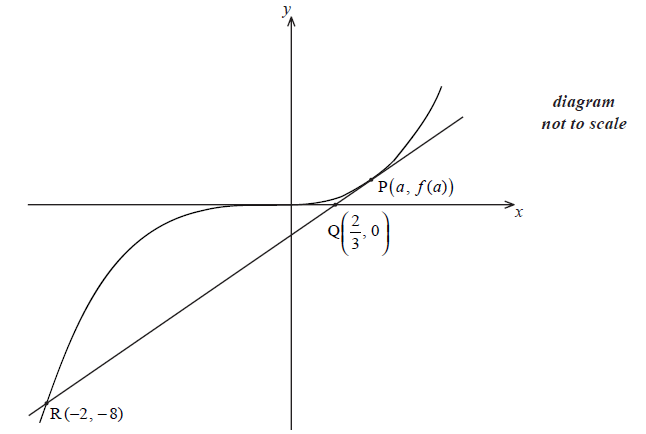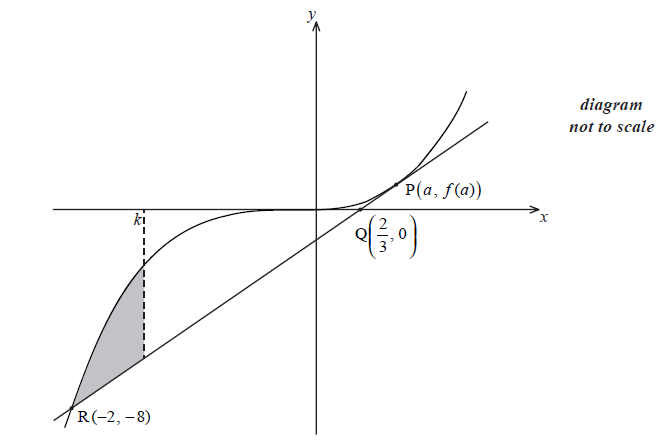| Date | November 2010 | Marks available | 7 | Reference code | 10N.1.sl.TZ0.10 |
| Level | SL only | Paper | 1 | Time zone | TZ0 |
| Command term | Find, Show that, and Hence | Question number | 10 | Adapted from | N/A |
Question
Let \(f(x) = {x^3}\). The following diagram shows part of the graph of f .

The point \({\rm{P}}(a,f(a))\) , where \(a > 0\) , lies on the graph of f . The tangent at P crosses the x-axis at the point \({\rm{Q}}\left( {\frac{2}{3},0} \right)\) . This tangent intersects the graph of f at the point R(−2, −8) .
The equation of the tangent at P is \(y = 3x - 2\) . Let T be the region enclosed by the graph of f , the tangent [PR] and the line \(x = k\) , between \(x = - 2\) and \(x = k\) where \( - 2 < k < 1\) . This is shown in the diagram below.

(i) Show that the gradient of [PQ] is \(\frac{{{a^3}}}{{a - \frac{2}{3}}}\) .
(ii) Find \(f'(a)\) .
(iii) Hence show that \(a = 1\) .
Given that the area of T is \(2k + 4\) , show that k satisfies the equation \({k^4} - 6{k^2} + 8 = 0\) .
Markscheme
(i) substitute into gradient \( = \frac{{{y_1} - {y_2}}}{{{x_1} - {x_2}}}\) (M1)
e.g. \(\frac{{f(a) - 0}}{{a - \frac{2}{3}}}\)
substituting \(f(a) = {a^3}\)
e.g. \(\frac{{{a^3} - 0}}{{a - \frac{2}{3}}}\) A1
gradient \(\frac{{{a^3}}}{{a - \frac{2}{3}}}\) AG N0
(ii) correct answer A1 N1
e.g. \(3{a^2}\) , \(f'(a) = 3\) , \(f'(a) = \frac{{{a^3}}}{{a - \frac{2}{3}}}\)
(iii) METHOD 1
evidence of approach (M1)
e.g. \(f'(a) = {\rm{gradient}}\) , \(3{a^2} = \frac{{{a^3}}}{{a - \frac{2}{3}}}\)
simplify A1
e.g. \(3{a^2}\left( {a - \frac{2}{3}} \right) = {a^3}\)
rearrange A1
e.g. \(3{a^3} - 2{a^2} = {a^3}\)
evidence of solving A1
e.g. \(2{a^3} - 2{a^2} = 2{a^2}(a - 1) = 0\)
\(a = 1\) AG N0
METHOD 2
gradient RQ \( = \frac{{ - 8}}{{ - 2 - \frac{2}{3}}}\) A1
simplify A1
e.g. \(\frac{{ - 8}}{{ - \frac{8}{3}}},3\)
evidence of approach (M1)
e.g. \(f'(a) = {\rm{gradient}}\) , \(3{a^2} = \frac{{ - 8}}{{ - 2 - \frac{2}{3}}}\) , \(\frac{{{a^3}}}{{a - \frac{2}{3}}} = 3\)
simplify A1
e.g. \(3{a^2} = 3\) , \({a^2} = 1\)
\(a = 1\) AG N0
[7 marks]
approach to find area of T involving subtraction and integrals (M1)
e.g. \(\int {f - (3x - 2){\rm{d}}x} \) , \(\int_{ - 2}^k {(3x - 2) - \int_{ - 2}^k {{x^3}} } \) , \(\int {({x^3} - 3x + 2)} \)
correct integration with correct signs A1A1A1
e.g. \(\frac{1}{4}{x^4} - \frac{3}{2}{x^2} + 2x\) , \(\frac{3}{2}{x^2} - 2x - \frac{1}{4}{x^4}\)
correct limits \( - 2\) and k (seen anywhere) A1
e.g. \(\int_{ - 2}^k {({x^3} - 3x + 2){\rm{d}}x} \) , \(\left[ {\frac{1}{4}{x^4} - \frac{3}{2}{x^2} + 2x} \right]_{ - 2}^k\)
attempt to substitute k and \( - 2\) (M1)
correct substitution into their integral if 2 or more terms A1
e.g. \(\left( {\frac{1}{4}{k^4} - \frac{3}{2}{k^2} + 2k} \right) - (4 - 6 - 4)\)
setting their integral expression equal to \(2k + 4\) (seen anywhere) (M1)
simplifying A1
e.g. \(\frac{1}{4}{k^4} - \frac{3}{2}{k^2} + 2 = 0\)
\({k^4} - 6{k^2} + 8 = 0\) AG N0
[9 marks]
Examiners report
Part (a) seemed to be well-understood by many candidates, and most were able to earn at least partial marks here. Part (ai) was a "show that" question, and unfortunately there were some candidates who did not show how they arrived at the given expression.
In part (b), the concept seemed to be well-understood. Most candidates saw the necessity of using definite integrals and subtracting the two functions, and the integration was generally done correctly. However, there were a number of algebraic and arithmetic errors which prevented candidates from correctly showing the desired final result.

